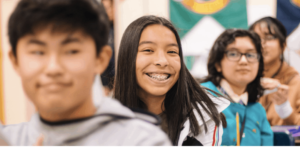Mentoring Your Students in Social Media or Vice Versa
 Generation Z is moving so fast we can only track their contrails. They have advertisers, marketers, and educators flummoxed with how they operate. What makes the Zs so different from the Boomers, Xs, and Ys? Quite simply, the Internet.
Generation Z is moving so fast we can only track their contrails. They have advertisers, marketers, and educators flummoxed with how they operate. What makes the Zs so different from the Boomers, Xs, and Ys? Quite simply, the Internet.
The internet is not technology for them. No more than the radio was technology for us. Or the apple was technology for Newton. It just exists for them as a common, ordinary, everyday tool. It’s NO BIG DEAL. Same for the iDevices, tablets, computers, phones, cameras, and everything thing else that’s digital. They’re not impressed by it. It is what it is.
The Zs, born after 1992, only know life with the Internet. The world is rapid for them. Answers, music, TV shows, movies, virtually anything can be found instantly.
The Zs are also all about social media. They love that Google +1 button, and the Facebook Like button, and comments section on all their favorite sites.
Most of us educators are wrapped up in social media, as well, but we’ve managed to keep education itself in a sterile environment, safe from the outside world. By the way, the outside world prefers to be called by its actual name: The Real World.
Naturally, many educators want to include their students in social media too, but they are not sure how to safely orchestrate an educational integration with networks like Facebook, Twitter, Foursquare, and so on.
So let’s get serious about making a social-networking strategy for our classroom. This needs to be a well thought-out strategy. Don’t just start friending students on Facebook and firing off tweets with tomorrow’s homework assignment on it. Let’s work on the plan first.
Facebook is a good place to start since it is apparently too big to fail. The FCC in its recent Children’s Internet Protection Act (CIPA) update, explicitly stated that using social networking sites like Facebook and MySpace were not in violation of CIPA. They even encouraged its use:
“Declaring such sites categorically harmful to minors would be inconsistent with the Protecting Children in the Twenty-First Century Act’s focus on “educating minors about appropriate on-line behavior, including interacting with other individuals on social networking websites and in chat rooms, and cyberbullying awareness and response.”
Fantastic! We’re all onboard.
Don’t discard your professionalism, though. You have worked long and hard for your professional educator title, so keep that in mind as you develop your educational networking strategy. Think about it, you will spend hours and hours planning for a single lesson, searching for the perfect video or link or assessment, so approach your networking strategy the same way. Don’t let this be a professional breakdown for you. Too much is at stake. Remember that the while the Internet doesn’t even register as technology for the Zs, it still does for the Boomers, Xs and Ys. Each older generation has more fears and distrust of technology than the generation that comes after it. And the older generation tends to include your bosses, and firing off the latest FCC updates to them might prove to be counterproductive.
Two Artifacts to Start With
Start with your district’s social networking policy. See what guidelines are in place. Some will not have one yet. Let yours be the professional model.
Create digital citizen guidelines for your students. Be explicit in how they will interact with you and other students on your networking sites. All students and parents should read and sign before they network on your sites. Write your guidelines in a clear, understandable language that both parents and students can understand. The district guidelines written for teachers is likely filled with eduspeak that can’t be understood by normal humans.
Here are two guides:
One Big Question
Should you friend students on Facebook? At this stage, I would advise not. There are too many difficult issues that could turn into minor or large headaches for you. The problem won’t be with you either. . . the professional educator . . . it will be with your friends . . . yes, those college buddies, sorority sisters, and outcast relatives who probably should not be mingling with your students on your Facebook wall.
One Easy Solution
Set up a Facebook page for your students. When students send a friend request, direct them to your Facebook page. Forget about Facebook groups. You have to friend students to add them to groups, and one of the settings for groups is “secret.” You want complete transparency for parents and administrators. Keep your professional hat on.
Facebook pages have really good controls now. In the page settings, you have tools like “Profanity Block” and “Moderation Blacklist.” You will still need to moderate your page, but these types of auto-moderation tools area a great help.
Facebook Page Strategy
On your Facebook page, you will be a mentor, not friend, to your students. While you network with them, you will teach them proper netiquette with your digital citizenship guide.
You, of course, will always be positive on your page and will reward their positive behavior. That’s not just good teaching, that also one of the underlying principles of Facebook. You’ve no doubt noticed that Facebook only has a “Like” button, and that’s for a reason.
Keep students and parents up-to-date with homework tips and tutoring help.
Tools to Use
Import Blogs and Twitter – If you have educational blogs and an educational Twitter feed, save time and integrate those right into your Facebook page.
Slideshare and Microsoft Live – Both are integrated with Facebook and are a great way to share content.
Instant Messaging – Message a parent “Adam did great on his project.” It will mean a ton to them!
“Ask a Question” Feature – This is perfect for formative assessments and polling students and parents.
Teacher Examples
You can find literally thousands of teacher pages on Facebook, but here are two to start with.
- https://www.facebook.com/pages/Mr-Edelmans-Teacher-Page/271175406351?sk=wall
- https://www.facebook.com/pages/PE-Kids-Going-Global-Postcard-Swapping/209600635717185?sk=wall
Final Thoughts
Remember that Facebook is not for everyone. You can’t force it on students, so be prepared to have an alternative for them. If it’s just a matter of access, allow those students to use your classroom computer or to have some “elbow time” with other students during class so that they can network, too.







luis
Computers are only assistants and a good teacher’s will always be needed. However social networks such as facebook and YouTube as well as great resources including Wikipedia and Wolfram-Alpha are here to stay so that educators must use them in the teaching process. Many academics are posting great educational videos and materials online.
The only problem is to sort the good ones from the rest and present them in an organized manner.
This effort is being done by: http://Utubersity.com which presents the best educational videos available on YouTube in an organized, easy to find way to watch and learn.
They are classified and tagged in a way that enables people to find these materials more easily and efficiently and not waste time browsing through pages of irrelevant search results.
The website also enhances the experience using other means such as recommending related videos, Wikipedia content and so on. There's also a Spanish version called http://utubersidad.com
This is a project that YouTube should embrace itself, with curated content from academics and maybe using a different URL (Youtubersity?) so it won’t be blocked by schools.
Carolyn DUrley
FInally someone who sees the value and power of using FB in the class! I completely agree that the teacher must keep the professional hat on at all times and I think due to the interpretive nature of posts you have to ere on the side of cautious.
I have been using FB with my classes for the last year and it has enormous potential. Students view FB as authentic and therefore it is not a chore for them to read class updates and reminders here.
Just a point though; you can have groups and not friend students. When you create the group you have to add one person to the group who is already a friend (so I usually use one of my real life friends), then after that non-friends can join. I keep administrative power of the group (tagging is approved by me alone).
I have had nothing but positive experiences using FB in my classes. i am dismayed when I read articles that instill fear around using FB with students.
Thanks for sharing you ideas!
tiny4.us
Hey I know this is off topic but I was wondering if you knew of any widgets
I could add to my blog that automatically tweet my
newest twitter updates. I've been looking for a plug-in like
this for quite some time and was hoping maybe you
would have some experience with something like this.
Please let me know if you run into anything. I truly enjoy reading your
blog and I look forward to your new updates.